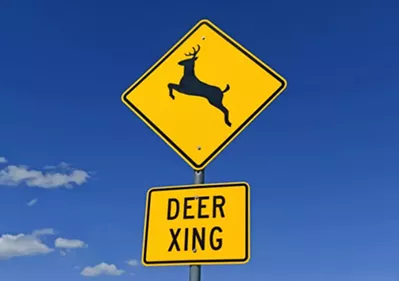Growing up in the country, about 25 miles outside of Spokane city limits, drives home from "town" after dark have never ceased to haunt me.
Whichever of us three kids were sitting in the front seat of our family's trusty Subaru wagon was tasked with being extra eyes on the road for our mom, scanning the darkened shoulders for the telltale glowing orbs or the flash of a shadow in the brush. We never hit a deer in all those years commuting on the rural highways from home and back, but there were many close calls.
Deer are estimated to be the cause of 1.2 million vehicle collisions in the U.S. each year. These careless and/or terrified creatures are thus responsible for the deaths of more than 200 people, for causing 29,000 injuries and more than $1.66 billion in vehicle damage, medical bills and road cleanup. Looking at these numbers, you're more likely to be killed or injured by a deer than any other animal species native to North America.
If only my childhood self, who also spent hours upon hours playing Little House on the Prairie in the pine woods of our 20-acre property, knew that deer — and not cougars — were the higher threat. For fear of the latter long-tailed apex predators, I would practice holding my full-skirted, homemade pioneer dress out with my arms like calico-printed wings — that's how you'd scare away a cougar, after all, by looking big and scary so it wouldn't eat you.
Anyway, all this reminiscing about suicidal deer and little-girl-hunting cougars brings me to the original point of this post — a new study released by a pair of researchers with the University of Idaho and University of Washington shows that if cougar populations in the wild were healthier, there would be less deer running out in front of cars on rural roads.
The research team headed by the U of Idaho's Sophie Gilbert and UW's Laura Prugh believe that if cougars were successfully re-established in the Eastern U.S. — the region in which their study was focused — over a 30-year period, the big cats would thin deer populations and thus reduce deer-auto collisions by 22 percent. In other words, we might be able to save 155 lives, prevent up to 21,400 injuries and create $2.13 billion in savings over that 30-year period.
On average, a cougar takes down more than 250 adult deer over its lifetime. Of course, the researchers acknowledge that increasing regional cougar populations could also increase the likelihood of big cats attacking humans, pets and livestock, but they argue the benefits would outweigh those risks. Other benefits of a reduced deer population include lower disease transmission rates (like Lyme disease) and a reduction in damage to crops and landscaping — which now totals billions of dollars annually.
Comparably, the report states that in the U.S. and Canada, between 1890 and 2008 there have been a reported total of 153 cougar attacks on humans, and 21 fatalities.
In a press release from the University of Idaho about the study's findings, researcher Gilbert says:
“The most important thing about this work is that it could help people understand that carnivores have some real benefits to offer human populations, in addition to costs that are often discussed.Find a complete copy of the study's results published by the conservation biology journal Conservation Letters online here.
So many people hit a deer or other big herbivore in their cars, or know someone who has, that I think people can really relate to that as a true risk in their lives. In the modern world, large carnivore populations will succeed only if we let them. That is why figuring out and communicating the benefits that they can provide to us, as well as the costs, could be a valuable tool for conservation efforts.”

